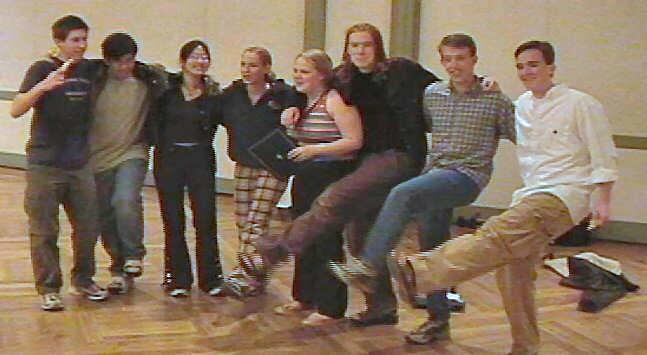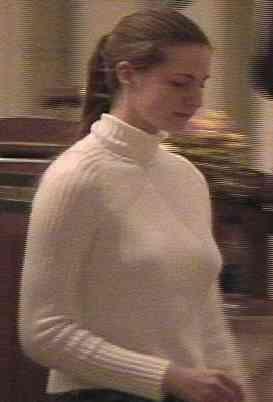
Eric LeSueur, Jonathon Climer, and Dan Grinols
Eric LeSueuer submitted the following nomination.
"Jonathon and I would like to nominate ourselves, and Dan Grinols for the Wylde Q. Chicken Award for our 2nd Quarter Statistics Project. We are all seniors (Class of 2002) and students in Carol Castellon's Statistics class.
For our 2nd Quarter statistics project, Mrs. Castellon wanted her students to integrate technology into a project dealing with a statistical topic. In the past, students have fulfilled this assignment by writing calculator programs, updating webpages, and testing new statistical software. We wanted to try something a little different. Frequently in class we watch "Teresa videos," which discuss real world applications of statistics. Eric had a video camera, and came up with the idea to do a similar project. We thought that it would be fun, but we had no idea what we would be getting ourselves into.
We decided that the topic we would discuss would be hypothesis testing and confidence intervals. But we needed a hook; something to drive the film. Based on an article in our textbook, we decided to research the "myth of the freshmen 15." We were able to use a small, portable camera, which gave us freedom to film spontaneous scenes and conduct candid interviews. With the freedom offered by this camera, we realized that the film was only limited by how much work we were willing to put into it. The problem was that once we got started, we kept creating new ideas for scenes. The following are some of the highlights of the movie:
-
Simulated 40 lb weight gain during fall semester.
-
Captions identifying group members as Professor Grinols, Professor Climer, and Professor LeSueur.
-
Eric's dog, Rory, delivering statistical definitions to Dan via mail.
-
Graph "punched-up" on computer is actually on a piece of paper scotch taped to computer monitor.
-
Narrator emerging from cubby beneath Eric's staircase.
-
Resorting to filming subbie yearbook photos of Dan, with Jonathon narrating, when Dan was detained at student production tech-week.
-
Jonathon being pushed into the bushes south of the Illini Union, by a self-conscious undergraduate.
In the end, including scenes like those listed above made the film an entertaining, not just informative project. Our group put in more hours than would normally be necessary. Even after we were done filming, we spent many nights refining the scenes and trying to edit them into a coherent order. We put in about 60 man-hours into the project. But it was worth the work; we were able to turn in a project we were proud of and the whole class enjoyed. If we weren't second-semester seniors, we wouldn't hesitate to do it again. Even through we were upset upon not receiving an Oscar for Best Original Screenplay, we think we are excellent candidates for the Wylde Q. Chicken award."
Honorable Mention: Pie Club

Jonathon Climer, Justin Lee, Crystal Chiang, Ann Murdoch, Emilia Garvey, Alex Mitchell, Eric LeSeuer, John Zech
David Stone, biology teacher, submitted this nomination:
"Pie Club is an unofficial club that meets during fourth hour to study and share food. In the past Pie Club has had events, including Emulation Week and a Fifth, Fondue Friday, Johnny Cash Day, and Evil Twin Tuesday. Pie Club is planning more events, including the Pie Club Movie/Tourist Day, the Pie Club Music Video, and April Fools Day pranks. Every day, a different person brings food (e.g. quiche, tiramisu, pie, pizza, cake, cookies, brownies) for the rest of the group. Pie Club brings food to Mr. Sutton, the U.S. History teacher, and sometimes Mr. Vaughn, the Philosophy and Eurasia History teacher, and Mr. Butler, the Eurasia and Modern History Teacher. Pie Club has offices and a crest.
Take six hungry seniors who don't really want to work and you've got the beginning of Pie Club. Eric LeSueur had some leftover pies from the boys' cross country Piefest, so he brought them in. Jonathon Climer, in his spontaneity, thought that it would be really cool to dress up as other people, thus Emulation Week and a Fifth was born. Justin Lee once joked that when John Zech was wearing all black, he looked evil, thus Evil Twin Tuesday was born. Since Alex Mitchell really likes Johnny Cash's "A Boy Named Sue," Crystal Chiang brought in a CD of it, thus Johnny Cash Day was born. Eric LeSueur decided that it would be really cool to have fondue one day, thus Fondue Friday was born. The upcoming events are the result of the creativity and wackiness of the Pie Club members.
I think that Pie Club celebrates the randomness and passion behind the development of so many Uni High clubs and organizations. It's been a great stress reliever for those involved. I have a hard time imagining anything more deserving of the Wylde Q Chicken Award."
Honorable Mention: A Concise Proof of the Mean Value Theorem
Nomination submitted by Emily Bruce:
"I would like to nominate Laura Book (class of 2003) for this year's Wylde Q. Chicken Award. Though she is, of course, constantly creative, spontaneously witty, etc., the specific "document" I want to nominate her for is "A Concise Proof of the Mean Value Theorem", 21 rhyming couplets in iambic pentameter. She wrote this (and I don't even want to think about how long it took her) after we had discussed the theorem in Calculus I (with Ms. Jockush). To show how much I think she should win the award, I've spent five minutes (we really ought to have typing at Uni...) putting it into the computer :) "

Laura's Book
The Mean Value Theorem (from "Calculus" by James Stewart)
Let f be a function that satisfies the following hypotheses: 1. f is continuous on the closed interval [a,b]. 2. f is differentiable on the open interval (a,b). Then there is a number c in (a,b) such that f'(c)=(f(b)-f(a))/(b-a).
A Concise Proof of the Mean Value Theorem by Laura Book
A function f which wishes to apply
to the Mean Value Theorem must satisfy
two guidelines, two concise hypotheses
of some of its intrinsic properties.
The first of which is that, on span [a,b],
it must for every point continuous be.
And second, on (a,b), it always must
be differentiable, without a cusp.
With that, the proof thereof proceeds as so:
You must the secant line's formula know,
which is, if a and b at the ends lie.
In point-slope format best to this applied.
Y equals f of a plus slope which is
from f of b, the f of a ridded,
divided by the difference b and a,
times x minus a, now forward go we may.
The proof is done by using Theorem Rolle.
On function h, which for right now we'll call
the difference of the functions f and g.
With g the secant line and f which we
have already defined; but if we will
use Rolle's Theorem, h must these guidelines fill:
The first of which is that, on span [a,b],
it must for every point continuous be;
a and second, on (a,b) it always must be
differentiable, without a cusp; And lastly,
h of a and h of b will be
the same; but to save time now we
won't prove these things in full, so on we'll go:
Because of this, Rolle to us now does show
that on the interval between [a,b]
there must exist a certain number c;
Derivative of h at this new place
is zero, which is also in this case.
The same as f of b less f of a
divided by the difference b and a
subtracted from the slope of f at c,
which means with that, that we
can say right now: the slope of f at c
is equal to the secant line's own slope,
which does pass through the endpoints a and b,
therefore, we're done with proving of the Mean Value Theorem.